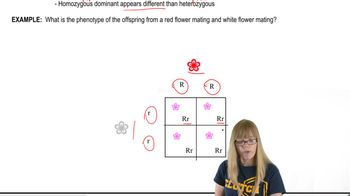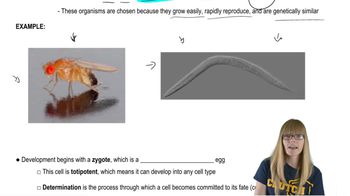Table of contents
- 1. Introduction to Genetics51m
- 2. Mendel's Laws of Inheritance3h 37m
- 3. Extensions to Mendelian Inheritance2h 41m
- 4. Genetic Mapping and Linkage2h 28m
- 5. Genetics of Bacteria and Viruses1h 21m
- 6. Chromosomal Variation1h 48m
- 7. DNA and Chromosome Structure56m
- 8. DNA Replication1h 10m
- 9. Mitosis and Meiosis1h 34m
- 10. Transcription1h 0m
- 11. Translation58m
- 12. Gene Regulation in Prokaryotes1h 19m
- 13. Gene Regulation in Eukaryotes44m
- 14. Genetic Control of Development44m
- 15. Genomes and Genomics1h 50m
- 16. Transposable Elements47m
- 17. Mutation, Repair, and Recombination1h 6m
- 18. Molecular Genetic Tools19m
- 19. Cancer Genetics29m
- 20. Quantitative Genetics1h 26m
- 21. Population Genetics50m
- 22. Evolutionary Genetics29m
14. Genetic Control of Development
Developmental Patterning Genes
Problem 19
Textbook Question
You are traveling in the Netherlands and overhear a tulip breeder describe a puzzling event. Tulips normally have two outer whorls of brightly colored petal-like organs, a third whorl of stamens, and an inner (fourth) whorl of carpels. However, the breeder found a recessive mutant in his field in which the outer two whorls were green and sepal-like, whereas the third and fourth whorls both contained carpels. What can you speculate about the nature of the gene that was mutated?
 Verified step by step guidance
Verified step by step guidance1
Step 1: Begin by understanding the normal floral organ arrangement in tulips. Tulips typically have four whorls: (1) outer whorl of sepals, (2) second whorl of petals, (3) third whorl of stamens, and (4) inner whorl of carpels. Each whorl is determined by specific gene expression patterns.
Step 2: Analyze the mutant phenotype described. In the mutant tulip, the outer two whorls are green and sepal-like, while the third and fourth whorls both contain carpels. This suggests a disruption in the normal differentiation of floral organs.
Step 3: Consider the ABC model of flower development, which explains how three classes of genes (A, B, and C) control the identity of floral organs. Class A genes specify sepals, Class A and B together specify petals, Class B and C together specify stamens, and Class C alone specifies carpels.
Step 4: Based on the mutant phenotype, hypothesize that the mutation likely affects a Class B gene. If Class B gene function is lost, petals (second whorl) and stamens (third whorl) fail to develop, and instead, sepals (Class A activity) and carpels (Class C activity) are formed in their place.
Step 5: Conclude that the gene mutated in this tulip is likely a Class B gene, which is essential for the development of petals and stamens. The recessive nature of the mutation indicates that both copies of the gene must be non-functional for the mutant phenotype to appear.
 Verified video answer for a similar problem:
Verified video answer for a similar problem:This video solution was recommended by our tutors as helpful for the problem above
Video duration:
4mPlay a video:
Was this helpful?
Key Concepts
Here are the essential concepts you must grasp in order to answer the question correctly.
Flower Structure and Whorls
Flowers are typically organized into whorls, which are layers of floral organs. The outer whorls usually consist of sepals and petals, while the inner whorls contain stamens and carpels. Understanding this structure is crucial for analyzing mutations, as changes in specific whorls can indicate alterations in developmental pathways.
Recommended video:
Guided course

Ribosome Structure
Dominance and Recessiveness in Genetics
In genetics, traits are often determined by alleles, which can be dominant or recessive. A recessive allele only expresses its trait when two copies are present. The observation of green, sepal-like outer whorls in the tulip suggests that the mutation is recessive, as it alters the typical phenotype when homozygous.
Recommended video:
Guided course

Variations on Dominance
Homeotic Genes and Floral Development
Homeotic genes are critical in determining the identity of floral organs during development. Mutations in these genes can lead to the transformation of one type of organ into another, such as carpels developing in place of stamens or petals. The tulip breeder's observation of carpels in the third and fourth whorls suggests a potential mutation in homeotic genes that regulate floral organ identity.
Recommended video:
Guided course

Genetics of Development
Related Videos
Related Practice
Textbook Question
In contrast to Drosophila, some insects (e.g., centipedes) have legs on almost every segment posterior to the head. Based on your knowledge of Drosophila, propose a genetic explanation for this phenotype, and describe the expected expression patterns of genes of the Antennapedia and bithorax complexes.
277
views


